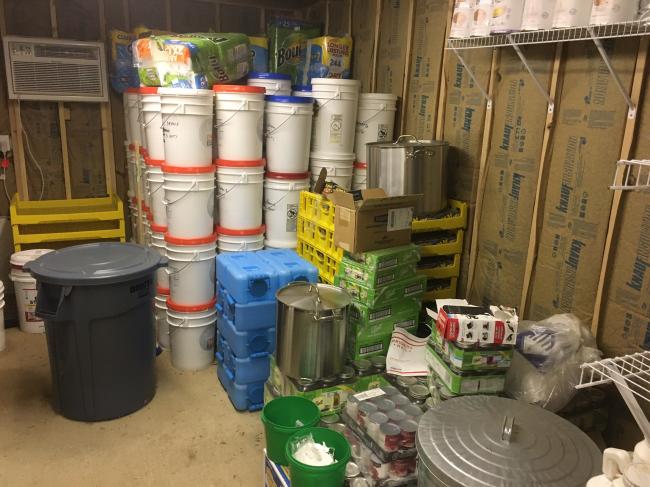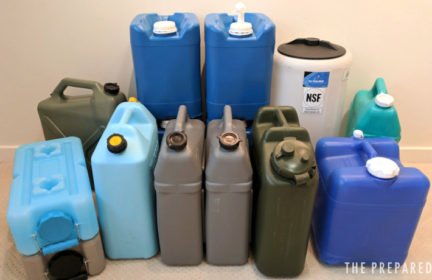-
Comments (17)
-
RedneckContributor - February 19, 2021
Water does not go bad but can get contaminated. I use the 3.5 gallon water bricks as a primary drinking water backup. I actually got in 8 more a week ago and have spent the last hour cleaning them with detergent & water. My wife’s mother lives in Memphis & because of several busted water mains, the pressure is very low and they have a boil water advisory. So I’m sending 4 of those water bricks in to Memphis with her, using our well water.
Any water storage container needs to be clean. The soap bath will kill most if not all of the possible germs. Any water that I put in long term storage, I add a bit of Clorox to ensure it stays safe… similar to the fluoride added to city water. Technically you should be able to store water indefinitely, if the container is cleaned properly, but to be safe, I change mine and reclean the containers every few years.
Here are some of my water bricks in storage.
-
Carlotta SusannaStaff - February 19, 2021
What Redneck said: Providing that you are filling your containers with tap water (which will already have some chemicals in it from the municipality) and that you are using food-grade clean containers, it should store indefinitely (or at least for a few years – I think that offical gudelines are 3-5 years to be safe). If you want to be extra sure you can add a litte bleach.
We have a few jerry cans and a 50 gal drum, they were all new when we filled them up. We just rinsed them up, filled with tap water only, ansd stored in a closet. We tasted the water from one of the cans after 3 years in storage and it was perfectly fine, albeit a bit flat-tasting.
Don’t know if you already saw them, but we wrote few guides on storing water. Here’s one of them https://theprepared.com/homestead/reviews/best-two-week-emergency-water-storage-containers/
-
Robert LarsonContributor - February 20, 2021
I took the water course from the prepared and learned lots of good tricks, so let me share a bit of what I learned:
Make sure your container is clean and free of contaminants before filling up. Even if it is new from the company, you don’t need those manufacturing juices in your water. Sanitize and clean every corner, nook, and cranny of the inside. I like wide mouth containers that I can stick a brush or rag into to give it a good clean.
And then for your water, if it’s from your tap in the city, it should be good for long term storage. If you are getting it from a well, a bit of bleach is needed.
Keep out of light and heat.
Water stored long term will taste flat (as also mentioned by Carlotta Susanna in this topic). But shaking it up and reintroducing some fresh oxygen makes it taste like normal again.
I still am going to rotate through my water every 3-5 years just to make sure it tastes good, is well oxygenated, and nothing nasty has been growing.
-
Lara B - February 20, 2021
I bought Scepter 5 gallon water containers this past September, prepped and filled them exactly as suggested in the link that’s been posted elsewhere in this thread, and stored them in a bedroom closet not any where near any sources of potential contamination. I live in Austin TX, hence no portable water from the taps right now, so I opened a container today, and am dismayed that the water tastes and smells so strongly of plastic it is borderline undrinkable. What’s going on? Is it safe to drink? Can I get rid of this taste? I’m so sad to think I tried to prepare the right way, but it seems to have backfired.
I appreciate any advice. Thanks.
-
Chubbz - February 20, 2021
Fellow Austinite here and new member. This whole experience has made me finally decide to jump into prepping.
In my experience plastic containers need to go through a few wash/fill cycles before the plastic taste/smell goes away. The water is probably fine to drink despite the smell. Once this is over and the boil-water notice has lifted, fill them up with water and a few tablespoons of baking soda, shake, and let them sit for a day or two. Then empty them out, wash them, and see if you still get a smell. If so, repeat. Typically 2-3 cycles of this is all it takes.
This is normal, don’t go throwing them away just yet!
-
UbiqueContributor - February 21, 2021
Hi Chubbz!
Baking soda has so many great uses and you nailed it as a suggestion for Lara B.
Welcome, I joined not long ago and have found this to be a very positive and knowledgeable group.
-
-
Bill Masen - February 21, 2021
Dammit I’m trying to stay off SP but I have to chip in on this topic, If you are going to store potable (drinking) water safely theres a few pointers you need to consider.
If there is a risk of freezing dont fill your containers to the top, only 3/4 full to allow for expansion.
Dont store on bare concrete floors , put the containers onto a pallet or piece of carpet. Concrete attracts fluids and ‘bleeds’. Anything that has been on or in that concrete will find its way into your plastic water barrel. This includes the lime in the concrete, any hazardous materials (i.e. gasoline, oils, kerosene, or anything a contractor used in construction), algae, etc. Usually, it is not enough to make the water toxic, but it will taint the water enough to make the taste unbearable. And no amount of pouring it from container to container will take that taste away.
Store in a dark room because light can trigger algal blooms turning the water green
Only use airtight containers.
Dont store Petrochems in the same room
I change the stored water every 6 months as it goes flat (not off) and it can absorb chemicals used in making the containers (in some cases gender affecting synthetic hormones)
-
UbiqueContributor - February 21, 2021
Bill – Excellent points, especially about strorage on bare concrete floors and petrochem storage in the same room.
One thing about storage on pallets, is that in some countries, we get pallets made with treated lumber. There are untreated pallets and that would be the only type I would use.
-
-
UbiqueContributor - February 21, 2021
This is also a point for anyone new to water storage and purchasing containers:
Storage containers are designed to hold different commodities. Food should be in food grade plastic containers, and water in a container designed to store water.
Those plastics are considered safe for those commodities.
Ensure the containers you purchase and use are actually made and graded as appropriate for storing water and not other liquids, like Gasoline or Diesel.
Traditionally: Red for Gasoline, Yellow for Diesel and Blue for Water.
Some manufacturers emboss the name of the the liquid on the container.
If you are uncertain, it is better to check and ensure you have the right container.
Plastics can commonly off gas. In addition to the recommended throrough (I do multiple washes), others have already suggested baking soda and a soak overnight. You can use lemon juice.
-
UbiqueContributor - February 22, 2021
Edit to add: Kerosene was stored in a type of blue container, so ensure it is the blue for water.
-
Bill Masen - February 22, 2021
Just a pointer, those colours for fuel are for the Americas, many other nations use different colour schemes. EG in the Uk there are NO legal colours for fuel storage but Petrol (gas) is normally GREEN and Diesel is Black.
-
-
Barb LeeContributor - March 8, 2021
We have a large rainwater storage tank. To ensure potability, we add one teaspoon Clorox to each 5 gallon jug we bring in the house. The jug is allowed to sit for at least 30 minutes, then the water is filtered through a Berkey gravity tabletop filter. There are directions on the Clorox website for sanitizing water.
-
Pops - March 8, 2021
Good info here.
One very important detail I think has been omitted: be sure you get Disinfecting Bleach, not just “Clorox”. Read the label for to find the active ingredient as there are new products on the market that make it confusing.
“Generally, the best cleaning, stain/soil removal and whitening is accomplished with the strongest bleach, which would be Clorox® Disinfecting Bleach. It also is the only disinfecting bleach and can be used around the house to clean and disinfect a wide variety of surfaces and problems. These (chlorine) bleaches have sodium hypochlorite as the active ingredient.”
https://www.clorox.com/products/clorox-regular-bleach2-with-cloromax/unscented/
https://www.clorox.com/wp-content/uploads/2017/09/Clorox_Regular_CloroMax_FactSheets_0911.pdf
-
RedneckContributor - March 8, 2021
So true. I add Clorox to my horses’ 60 gallon water trough each week. Last year, by mistake, I picked up some Clorox that was a no spill formula. With it, every time I added water, I had huge towers of soapy foam coming from the trough. I guess they add soap or similar to keep it from spilling.
-
Bill Masen - March 8, 2021
That would be unscented unthickened Domestos in the UK.
-
NeedToKnow - November 13, 2022
I have seen forum members suggest calcium hypochlorite powder (“pool shock”) in stored drinking water. Would it work to use sodium hypochlorite powder instead? Would there be an advantage to one of these powders over the other? Sodium hypochlorite is the active ingredient in Clorox, and is available online in several different size containers.
-
Gideon ParkerStaff - November 15, 2022
Personally I would lean more towards the pool shock (calcium hypochlorite) because there is more data on people using it on a personal level, even the EPA lists how to use it.
From what I can tell, sodium hypochlorite is more so used to treat water in city water treatment facilities. I was able to find one research study though that gave guidance on how to use it:
- 1.88 mg/L and used within 24 hours for low turbidity sources
- 3.75 mg/L and consumed within 8 hours for higher turbidity sources
So it seems like you could use sodium hypochlorite and it’s probably better than nothing. But without more evidence of people using it personally for storage/treatment, I err on the side of caution and stick with what’s known.
-
-
- News for the Week 2025-12-22 - 3 days ago
- News for the Week 2025-12-15 - 1 week ago
- News for the Week 2025-12-08 - 2 weeks ago
- Building a ‘hospital bag’ - 3 weeks ago
- News for the Week 2025-12-01 - 3 weeks ago
This forum is heavily moderated to keep things valuable to as many people as possible. Full community policies are here. The basics:
- 1. Be nice to each other.
- 2. Stay focused on prepping.
- 3. Avoid politics, religion, and other arguments.
- 4. No unfounded conspiracies, fake news, etc.
- 5. Debate ideas, not people.

